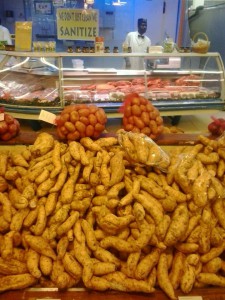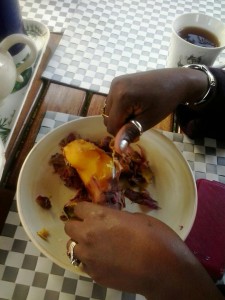- National Heirloom Exposition coming up. Any of our readers going? Oh come on, one of our readers must be going!
- Kew head honcho calls for a botanical New Deal.
- WorldFish head honcho calls for an aquacultural New Deal.
- A papyrus of recent botanical literature on ancient Egypt.
- Coffee blogs to follow. Oh gosh, am I blushing?
- Participants “gain more knowledge” at policy workshop. Of the ITPGRFA, that would be.
- A couple of Chinese agricultural systems gain recognition as Globally Important Agricultural Heritage.
OFSP steal the show


What I read on my summer holidays
Yeah, summer is over and I’m back at work. Maybe you noticed I haven’t contributed much here in the past month or so. Or maybe you didn’t. Jeremy kept up a steady stream of agrobiodiversity nuggets pretty much all through August. But my lack of activity on the blog doesn’t mean I haven’t tried to keep up, as you would know if you followed us on Facebook, Twitter or Scoop.it. Anyway, for those that don’t, and would like to catch up on my summer reading, here is, in nibble form, what caught my eye during the past month or so:
- “The potato is a religious commodity in America.” Explaining the governance crisis in the US using the humble spud.
- Wait a minute though: “The sizzle seems to be gone from America’s long-term relationship with the potato.” Which apparently means it needs an extreme makeover, colour-wise. For which you’ll need a genebank.
- A tree’s leaves can be genetically different from its roots. Does that mean we have to re-think all molecular phylogenies?
- And speaking of a tree’s leaves, these ones are a thousand years old and give you a buzz.
- A toff with a passion for pigs. P.G. Wodehouse had something to say about this, didn’t he?
- Turns out WFP has a podcast. And ICIMOD has an RSS feed.
- A mathematician factchecks Michael Pollan.
- Pear with me please, while I tell you about another USDA fruit collection.
- 15 Africa-changing innovations include orange-fleshed sweet potatoes. As if they weren’t there before. Anyway, they were THE story for a couple of weeks in August.
- 12 food security innovations include increasing crop diversity. With orange-fleshed sweet potatoes?
- How to put that banana genome to some use.
- Getting the most out of your enumerators.
- IUCN’s Conservation Campus. Any ag? And on a similar topic, training materials in anthropology.
- Automating conservation assessment of plants. You’ll need provenance data from herbaria such as this one at CIP, of course. Oh, and speaking of CIP, they need a phylogeneticist.
- A market opportunity for the mother-in-law?
- Measuring the health of the oceans. Hey, but it’s not all bad for fish.
- Ten species which rely on ex situ conservation. And why that number will go up. How to pay for it all, though?
- Book on the recent history of agricultural research reviewed. I wonder if they looked at the private sector. Because it seems there may be a case to answer.
- Another big grant for taxonomic databases. Ah but this is all going to be community-driven.
- Looks like this Australian genebank could have done with a decent database, community-driven or not.
The complexities of conserving crop diversity in Italy
A certain Mario C. has collected 178 signatures for a petition to save the “Banca dei Semi di Bari”:
We the undersigned ask the judges responsible, the National Research Council, and the political authorities at national, regional, provincial and city levels to “Save at any cost the Seed Bank of Bari.” Including if necessary delivering these seeds to us or other third parties who love nature, so they do not die. For example, as has been done by the Public Prosecutor’s Office of Brescia when they delivered Green Hill beagle dogs to ordinary citizens (about 2500 beagles) to save them from vivisection.
The Italian genebank in question, the largest in the National Research Council’s (CNR) network, is thus described:
It’s the first seed bank in Italy and the second in Europe. It maintains 84,000 germplasm samples from more than 60 genera and over 600 species of cultivated plants. It was established by FAO to expose the high genetic erosion caused by the Green Revolution.
Skipping blithely over the somewhat distorted version of the history of the Bari genebank, the numbers quoted 1 suggest that this is a reaction to a recent article in a local paper, which had this to say about the nature of the threat to the genebank, unhelpfully not mentioned in the petition:
Way back in 2003, the temperature of the cold rooms rose above the optimal, that is -20-0°. Failure to repair the rooms in timely fashion by the CNR has caused extensive damage to the genetic heritage so that, following a dispute between the Bank and the National Research Council (CNR), an investigation by the judiciary found CNR to be responsible. Although the samples have been released from seizure since 2009, the Region of Puglia apparently has not yet acquired them to provide for their regeneration. No one else has offered to do this and they are back in the hands of the CNR. Meanwhile an immense and invaluable genetic agrobiological patrimony is perishing abandoned.
In past years appeals by, among others, Dr Perrino to protect the biodiversity represented and perpetuated through these seeds from being destroyed have gone unheeded. To prevent the worst is simple, just regenerate this germplasm by planting it. Inexplicably, no one seems interested in doing this, starting with the political class, according to Perrino, former director of the Institute of Germplasm of CNR, Bari (1983-1993, 1998-2002).
Now, I don’t know to what extent these allegations are justified. There’s no mention of any problem in Italy 2 in the recent big official EU document on PGRFA. Not that you’d necessarily expect to find mention of such problems in big official EU documents. There’s been nothing much on the grapevine. Not that that’s always reliable. The whole thing may just be a misunderstanding. But this has been going back and forth for years now. It would be nice to have some data from the Bari genebank to settle the question once and for all. Regular germination tests are surely carried out there. The results are surely documented. Why not publish them, and set everybody’s mind at rest? And to what extent is the issue moot anyway, the material in Bari being duplicated elsewhere?
Meanwhile, there’s a press release from the Italian ministry of agriculture contextualizing the recent EU court decision that the prohibition on commercializing seed of traditional varieties is invalid. Jeremy said there was probably more to it than that, and of course there is. Apparently, you still have to register your traditional variety in Italy. But it only takes 150 days, the ministry assures us, it’s not too difficult, and entirely free.
Ex situ or in situ, conserving crop diversity can sometimes seem a vale of tears.
Brainfood: Lathyrus sativus, Leafy green porridge, iDArTs, Pungency, Earth ovens, Domestication, Recovery, Maize genomics
- Exploring the genetic diversity of Ethiopian grass pea (Lathyrus sativus L.) using EST-SSR markers. They’re variable, especially in Gonder, and future collecting missions need to give “due attention to underrepresented regions”.
- Green leafy porridges: how good are they in controlling glycaemic response?. Pretty good, but the leafy greens may not be what you’re expecting.
- iDArTs: increasing the value of genomic resources at no cost. No cost for genotyping, that is; the analysis probably does cost.
- A versatile PCR marker for pungency in Capsicum spp. Beats having to taste each progeny plant, I suppose.
- Earth Ovens (Píib) in the Maya Lowlands: Ethnobotanical Data Supporting Early Use. The food preparation method is as old as the food itself; 3400-3000 bce.
- Patterns and processes in crop domestication: an historical review and quantitative analysis of 203 global food crops. Terrific, broad survey, worth more of a write-up.
- Changes in Avian and Plant Communities of Aspen Woodlands over 12 Years after Livestock Removal in the Northwestern Great Basin. Removing livestock leads to “recovery of biological integrity”. Because livestock are not integral to anything.
- Historical genomics of North American maize. Fascinating analysis indicates selection based on a limited set of ancestor lines, and “decreased diversity in the ancestry of individual lines”.